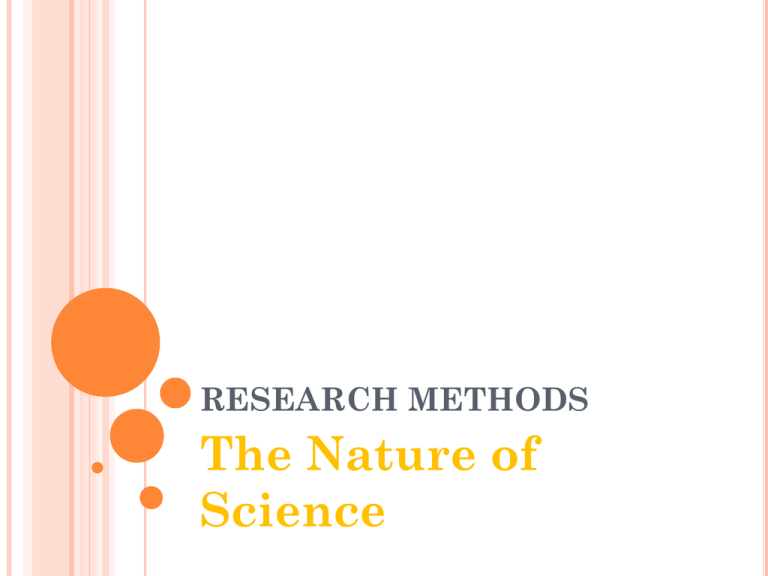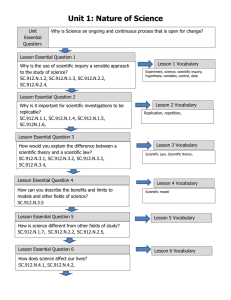1 what is science
advertisement

RESEARCH METHODS The Nature of Science WHAT IS SCIENCE? You can’t study psychology without being aware of what science is (Dyer 2006) Learning Objectives You will need to identify the key features of science. You will need to be able to distinguish science and non-science. THE NATURE OF SCIENCE KARL POPPER Falsification: The process of proving an hypothesis incorrect. This is the only way that Scientific knowledge can be built up. WHAT IS SCIENCE? According to Williams (2000) science is the practice of generalising from observations to form a rational explanation…a theory of a particular part of the world and then testing that theory by experiment, rejecting it if it does not match up and accepting it if it does. BALONEY DETECTION KIT BY CARL SAGAN Carl Sagan referred to science as a candle in the dark of the demon haunted world. “Science is a way of thinking much more than it is a body of knowledge.” WHAT IS SCIENCE? Science is a method for obtaining information about the world in an objective manner. It is empirical: that means that experience or evidence are central to how we obtain the information. Science is replicable. The procedures can be reproduced and repeated. Science is rational. That is it is based on reason. EMPIRICAL METHOD AND DEDUCTIVE REASONING 1.The Hypothesis 3a. Not supported 3b. Supported 2. Test hypothesis Theory IN (OTHER) WORDS By employing empirical methods we can develop hypotheses which we can go out to test. We are engaging in deductive reasoning, we have a theory or hypothesis that we assume to be correct we test it in various ways to see if it stands up. Sometimes called the hypotheticodeductive method. IN OTHER WORDS AGAIN 1. The hypothesis: this is a testable statement, based on the aims of our research. 2.Test hypothesis: We test it with appropriate methods. 3a. Do Not support Hypothesis: We go back to drawing board and rethink the hypothesis. 3b: Supported: if the results of number 2 are supportive we move on to the final stage. 4. The theory: this allows us to support or modify a theory. SCIENCE VERSUS NON-SCIENCE Science Findings found in journals that are peer reviewed. Results can be replicated. Over time we learn more. Evidence based. Old ideas are abandoned when new evidence is found. Does not advocate or market unproven practices or products Non-Science (pseudo science) Findings made available to the general public. Results not able to be replicated. No progress made. Faith based or appeals to belief. Original idea is never abandoned no matter what-ever the evidence. Questionable products marketed. Reading extension Bad Science - Ben Goldacre How to lie with statistics - Derrel Huff Counter-knowledge - Damien Thompson Why people believe weird things - Michael Shermer. SCIENCE AND NON SCIENCE Common Sense explanations. From our own ideas about what is true about the world. Rarely tested. Based on limited information Based on intuition. Ask people the question about whether or not they would give somebody 450 volts of electricity in an experiment. Belief based. These may be religious, political or personal. Can be based on little or no evidence. Can be claimed to be true even when faced with contradictory evidence. 507 PSEUDOSCIENCE IS FALSE SCIENCE Presented as scientific even though it is not. Pseudo science is vague and not easily replicated. Pseudoscience is published in non-verified sources i.e. the internet. THE SCIENTIFIC PROCESS – Key ideas The scientific method – uses Induction and Deduction. There is a The research cycle. The scientific method is known as Hypotheticodeductive method According to Karl Popper, a theory is scientific only in so far as it is falsifiable, and should be given up as soon as it is falsified. Popper suggests that the trying to disprove a theory often strengthens it. Scientists share a set of assumptions about the the subject matter and the methods used to study it. This is known as a paradigm. These assumptions limit the types of questions that they ask. In light of new information sometimes there are Paradigm shifts. Psychology has no single paradigm Create a poster to show the difference between real science and pseudoscience – use key terms






